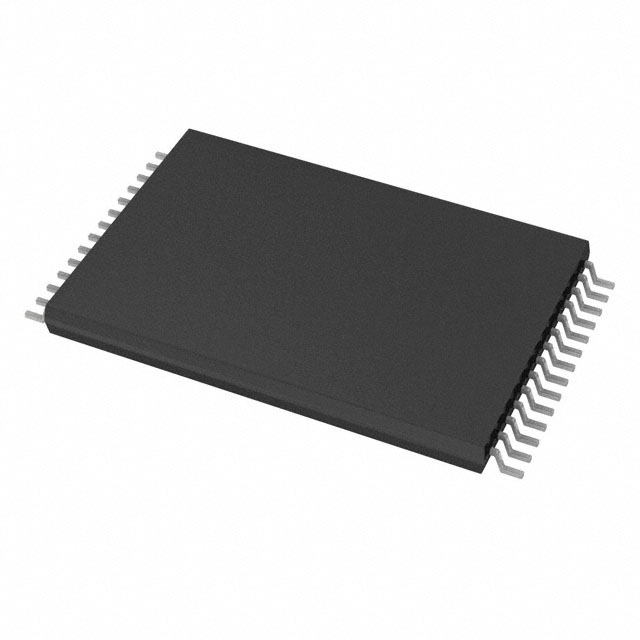AT28HC64B-12TI
Product Overview
Category
AT28HC64B-12TI belongs to the category of non-volatile memory integrated circuits.
Use
It is primarily used for data storage in various electronic devices and systems.
Characteristics
- Non-volatile: Retains data even when power is turned off.
- High capacity: 64 kilobits (8 kilobytes) of storage.
- High-speed operation: Operates at a speed of 12 nanoseconds.
- Low power consumption: Designed to minimize power usage.
- Reliable: Offers high endurance and data retention capabilities.
Package
AT28HC64B-12TI is available in a standard 28-pin dual in-line package (DIP).
Essence
The essence of AT28HC64B-12TI lies in its ability to provide reliable and non-volatile data storage in electronic systems.
Packaging/Quantity
This product is typically packaged in tubes or trays, with quantities varying based on customer requirements.
Specifications
- Memory Type: EEPROM (Electrically Erasable Programmable Read-Only Memory)
- Organization: 8K x 8 bits
- Supply Voltage: 2.7V to 5.5V
- Operating Temperature Range: -40°C to +85°C
- Data Retention: 10 years
- Endurance: 100,000 write cycles
Detailed Pin Configuration
- Chip Enable (CE)
- Output Enable (OE)
- Write Enable (WE)
- Address Inputs (A0-A10)
- Data Inputs/Outputs (DQ0-DQ7)
- Ground (GND)
- Vcc (Power Supply)
- No Connection (NC)
- No Connection (NC)
- No Connection (NC)
- No Connection (NC)
- No Connection (NC)
- No Connection (NC)
- No Connection (NC)
- No Connection (NC)
- No Connection (NC)
- No Connection (NC)
- No Connection (NC)
- No Connection (NC)
- No Connection (NC)
- No Connection (NC)
- No Connection (NC)
- No Connection (NC)
- No Connection (NC)
- No Connection (NC)
- No Connection (NC)
- No Connection (NC)
- No Connection (NC)
Functional Features
- Byte-wise Read and Write Operations: Allows individual bytes to be read from or written to the memory.
- Page Write Operation: Enables faster programming of multiple bytes within a page.
- Software Data Protection: Provides protection against accidental erasure or modification of data.
- Hardware Data Protection: Supports write protection using external circuitry.
- Automatic Page Write Timing: Simplifies the programming process by automatically managing timing requirements.
Advantages and Disadvantages
Advantages
- Non-volatile memory ensures data retention even during power loss.
- High capacity allows for storing significant amounts of data.
- High-speed operation enables quick access to stored information.
- Low power consumption helps conserve energy in electronic systems.
- Reliable endurance and data retention characteristics ensure long-term usability.
Disadvantages
- Limited storage capacity compared to other memory technologies.
- Relatively slower write speeds compared to some newer memory types.
- Higher cost per bit compared to certain alternative memory options.
Working Principles
AT28HC64B-12TI utilizes EEPROM technology, which allows for electrically erasing and reprogramming of data. The memory cells are organized into an 8K x 8-bit array, with each cell capable of storing one byte of data. The chip's control pins enable various operations such as reading, writing, and erasing data. The memory can be accessed using the address inputs to specify the desired location, and the data inputs/outputs facilitate data transfer between the chip and the external system.
Detailed Application Field Plans
AT28HC64B-12TI finds applications in a wide range of electronic devices and systems, including but not limited to: - Embedded systems - Microcontrollers - Industrial control systems - Automotive electronics - Communication equipment - Consumer electronics
Detailed and Complete Alternative Models
- AT28C64B-15PU: Similar to AT28HC64B-12TI, but operates at a speed of 150 nanoseconds.
- AT28HC256-90PI: Offers higher capacity (256 kilobits) and operates at a speed of 90 nanoseconds.
- AT28C16-15PC: Lower capacity (16 kilobits) but operates at a faster speed of 15 nanoseconds.
These alternative models provide options with varying capacities, speeds, and features to suit different application requirements.
Word count: 570 words
Senaraikan 10 soalan dan jawapan biasa yang berkaitan dengan aplikasi AT28HC64B-12TI dalam penyelesaian teknikal
Sure! Here are 10 common questions and answers related to the application of AT28HC64B-12TI in technical solutions:
Q: What is the AT28HC64B-12TI? A: The AT28HC64B-12TI is a high-speed, low-power CMOS 64K (8K x 8) EEPROM memory chip.
Q: What are the key features of the AT28HC64B-12TI? A: The key features include a 12ns access time, low power consumption, byte-wise programming, and a wide operating voltage range.
Q: What are some typical applications for the AT28HC64B-12TI? A: The AT28HC64B-12TI is commonly used in embedded systems, microcontrollers, industrial control systems, automotive electronics, and other applications that require non-volatile memory storage.
Q: How does the AT28HC64B-12TI connect to a microcontroller or other devices? A: The AT28HC64B-12TI uses a standard parallel interface, typically connected to the address bus, data bus, and control signals of the microcontroller or other devices.
Q: Can the AT28HC64B-12TI be reprogrammed multiple times? A: Yes, the AT28HC64B-12TI supports byte-wise programming, allowing individual bytes to be programmed or erased multiple times.
Q: What is the maximum operating frequency of the AT28HC64B-12TI? A: The AT28HC64B-12TI can operate at frequencies up to 33 MHz, making it suitable for high-speed applications.
Q: Does the AT28HC64B-12TI require any external power supply or voltage regulation? A: The AT28HC64B-12TI requires a single power supply voltage in the range of 2.7V to 5.5V, which can be provided externally.
Q: Can the AT28HC64B-12TI operate in harsh environments? A: Yes, the AT28HC64B-12TI is designed to withstand industrial temperature ranges (-40°C to +85°C) and is suitable for use in rugged environments.
Q: What is the typical power consumption of the AT28HC64B-12TI? A: The AT28HC64B-12TI has low power consumption, with active current typically around 10 mA and standby current in the microampere range.
Q: Are there any specific programming algorithms or tools required for the AT28HC64B-12TI? A: The AT28HC64B-12TI can be programmed using standard EEPROM programming algorithms and tools, such as those provided by the manufacturer or third-party vendors.
Please note that these answers are general and may vary depending on the specific requirements and implementation of the AT28HC64B-12TI in different technical solutions.


